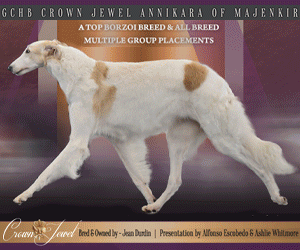From The CC Vault: Wind At Your Back – Life Is A Choice…
Originally published: September 2015
Life is a choice, Choose to live it
Everyone has heard the phrase “the wind at your back”. It has been used by sailors and those struggling to succeed for decades. The idea is straightforward. When the wind is at your back you get an advantage from the push and its force. In the world of dogs, two examples come to mind when I hear someone use this phrase. The first occurs when breeders develop the eight skills needed to breed and exhibit their dogs. The second occurs when researchers and the canine community combine efforts to discover better methods to improve our health. Both illustrate that a little extra help can make a significant difference. Skill development increases knowledge and provides the push and advantage that makes the difference when there is competition for quality.
The dog world is full of folklore and myth which often leads to mistakes and poor decisions. In turn, the lack of reliable information influences decisions and beliefs. In my years as a breeder and professor I always looked for ways to put some wind at my back. At the University, my efforts would begin each semester during the first three days of classes. These days are called “Drop and Add”. For three days students can opt to drop a class and enroll in another. For many students these three days are strenuous, so I tried to help them make up their mind about my class. I began with the following phrase on the chalk board.
“Those who do not read have no advantage over those who can’t.”
It usually got their attention and they would begin to wonder about the amount of homework I would assign them. For others they discovered that getting up for an early class on cold mornings was not what they wanted, so they would drop the early class for another later in the day. To help my students decide about my class, I began with an explanation about grading their tests. I set the stage with a story about a class I took in graduate school. That professor told us on the first day of class that he would give us four tests; all would have 100 questions with multiple choice answers. Then he said, “If you get them all right, you get an ‘A’, if you miss one, you get a ‘B’, if you miss two, you get a ‘C’, if you miss more than that, an ‘F’. I decided to use a different approach. I tell my students there will be four tests, 100 questions each, all multiple choice questions, and that 50% of the test questions would come from their homework. Those who wanted to avoid homework would drop my class because they knew they could not pass the course without reading and doing the homework assignments. The phrase on the chalk board set the stage. I did all this because I knew that the little bit of time I had with my students each semester was not enough to teach them everything they needed to know about the subject. I tell this story in this article for the same reason. In the small amount of space allowed me for this subject, I cannot adequately cover this topic, therefore I offer the reader references where they can learn more. This is my way of putting some wind at their backs.
Other examples come to mind that illustrate this point. They come from the paradigm shift in the role that has emerged for dogs and their historical use as companions and co-workers. In our modern world which now relies on science, the canine has become a full-fledged partner in health research. This shift in usage has opened new doors for human health and longevity. The positive side-effects for dogs can be directly related to the selective breeding which over several centuries has created breeds with verifiable ancestry. Because these closely monitored populations have short life spans, they make ideal populations for the study of canine and human diseases.
When the canine genome sequencing project was undertaken a few years ago, the American Kennel Club/Canine Health Foundation (AKC/CHF) joined others to advance genetic research in order to find the causes – and cures – for diseases. This new partnership produced discoveries that today include breakthroughs in Neuronal Ceroid Lipofuscinosis in Tibetan Terriers that led to landmark stem cell replacement therapy for a California boy who was suffering with the human equivalent called Batten Disease. Other tests were developed for copper toxicosis in Bedlington Terriers, juvenile cataracts in Boston Terriers, and better methods to treat the transmission of tick-borne diseases and Rocky Mountain spotted fever in Basenjis, Standard Poodles, and English Cocker Spaniels. Today more than 74 schools and research institutes worldwide, including those in Great Britain, Germany, Australia, and the Netherlands are now working toward the advancement of canine health and research with the establishment of a DNA Repository. The collaboration of the AKC/CHF and the Orthopedic Foundation for Animals (OFA) produced the Canine Health Information Center (CHIC), which also offers a data base for breeders and researchers.
All of this remarkable work, and the profound implications associated with genetic research, dates back to the 1850s when Gregor Johann Mendel, an Austrian Monk, joined a scientific group that was interested in basic research. The society asked its members to pick a subject of interest, do research, and report it to the society at their annual meeting. Mendel’s interest was in the area of heritability and how parents were able to pass on their traits to their offspring. Little was known about this subject and most of what was known was based on folklore and myth. During the early 1800s, those who held positions of authority were regarded as the final word on matters, so imagine then, that a monk who had never been with women or fathered a child, steps forward and states that based on his research, the male and female each contribute 50% to the makeup of their offspring.
His discovery caused great concern and required a new way of thinking. Mendel had proposed that there were particles (genes) which could not be seen by the naked eye that caused traits to appear and others to be carried and not seen. Most of the important pieces to this complex puzzle that he had assembled focused on the curious patterns of heredity. Mendel’s discovery came about by repeating the garden pea plant crosses that had been done by Knight earlier. The difference between Mendel’s experiments and Knight’s was that Mendel used mathematics to explain his results. Unfortunately, in the 1850s mathematics was not part of science and Mendel’s colleagues could not accept his explanations of inheritance based on what could not be seen. Without a chalk board, his audience had to follow his explanation about how he grew 929 offspring, or F2 individuals, which involved 705 plants with purple flowers and 224 with white flowers. He explained his results without the use of two terms, the “chromosome” and the “gene”, neither of which were known at the time. The discovery of the chromosome would not be known until 1879 when the German scientist Walther Flemming discovered it. The concept of the gene would not be discovered until 1902 when the American biologist Walter Sutton gave a convincing argument supporting an earlier notion that “genes” were located on the chromosomes. Mendel studied all of this and the complications of inheritance without knowing about genes or chromosomes. His work involved seven traits in his flowers. He observed: flower color, seed color, seed shape, pod color, pod shape, flower position on the stem and plant height. Each of these traits had two contrasting forms. A flower color could be purple or white and it could also be tall or short. His paper (1865) described in detail his experiments, but it was not published until 1866. Unfortunately, Mendel did not have a PowerPoint projector or a chalk board, which forced his audience to follow a mathematical explanation, involving the crossing of seven traits and the variations in traits that occurred. They also had to accept the idea that some traits were dominant and others recessive. Mendel died on June 1, 1884, not knowing the significance of his discoveries. After his death, his writings, experiments and materials were stored in the school’s library where they remained virtually unnoticed until 1900 when Carl Correns, Hugo de Vries and Eric von Tschermak, three researchers from Germany and Holland, independently began to study Mendel’s experiments and launch their own studies. What is more interesting is that their results were very much like those Mendel had discovered forty years earlier. To their amazement, what they were looking for had already been found by Mendel in the 1860s. Today we call this science ‘genetics’.
Mendel needed some wind at his back, but it would not come in his lifetime. When it did come, the wind would be a simple diagram called the Punnett Square. The name comes from the British geneticist Reginald Punnett who understood what Mendel was trying to explain. Punnett was able to explain Mendel’s discovery with a two-by-two diagram (Figure 1). Dominant traits were drawn with a capital letter (B) and recessives with a lower case (b). He explained that each parent passed on one of their genes to their offspring. This resulted in combinations of pairs, (BB, Bb, and bb). For example, when two carriers are bred (Bb x Bb) they produce 25% dominate offspring (BB); 50% carriers (Bb), and 25% affected (bb) as seen in Figure 1.
For example, using Figure 1, suppose that two pups are born instead of the four shown. They could both have short coats (BB) or they might both have recessive coats (bb) which are the long, shaggy, and feathered or powder puff varieties. The frequencies seen in Figure 1 are the mathematical percentages that could occur if a breeding is repeated several times. To better understand the Punnett Square, consider that a litter might only have one pup and it could have a normal coat and be a carrier of the trait (Bb) or it could have a normal coat (BB) or it could have a recessive (bb) coat. If the recessive coat occurs (bb), the breeder would know that both parents were carriers (Bb). Breeders can learn about the carriers in their pedigrees by keeping records, because recessive traits can remain in the background for several generations.
Aquick glance at several AKC breed standards shows that many describe dominant and recessive coat types and pigments. The Punnett Square, combined with good records, will put wind at the back of a breeder. Lloyd Brackett, a famous breeder of the 1950s often said, “With this kind of knowledge, why not breed by direction rather than by chance”.
References:
• Battaglia, C.L. – Breeding Dogs to Win, BEI Publications, Atlanta Ga., 2009.
• Bell, Jerold, Developing a Healthy Breeding Program, National Parent Club Canine Health Conference, AKC Canine Health Foundation, St. Louis MO. October 15-17, 1999.
• Hutt, Fred, Genetics for Dog Breeders, WH Freeman Co., San Francisco, CA, 1979
• Willis, Malcolm, Breeding Better Dogs (Key Note Address) National Parent Club Canine Health Conference, AKC Canine Health Foundation, St. Louis, MO. October 15-17 1999.
• Willis, Malcolm, Genetics of the Dog, Howell Book House, New York, New York, 1989
• Willis, Malcomb, Breeding Dogs, Canine Health Conference, AKC Canine health Conference, Oct. 15-17, 1999. St. Louis, MO.
• Willis, Malcomb, The Road Ahead, AKC Gazette, August 2000, Vol. 117, number 8, p-47.
ABOUT THE AUTHOR
Camen L. Battaglia holds a Ph.D. and Masters Degree from Florida State University. As an AKC judge, researcher and writer, he has been a leader in promoting ways to breed better dogs. The author of many articles and several books, he is a popular TV and radio talk show guest.
Short URL: https://caninechronicle.com/?p=291682
Comments are closed













